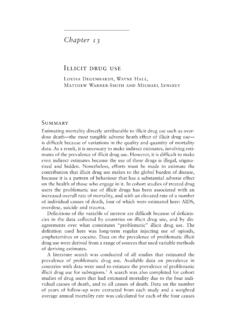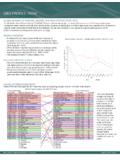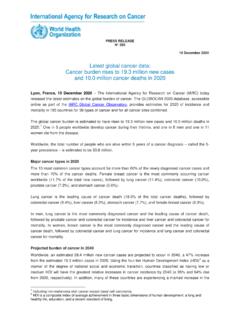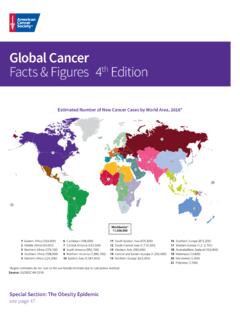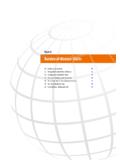Transcription of NCD Burden of Disease - Centers for Disease Control and ...
1 NCD Burden of Disease Presenter's Name Presenter's Title Title of Event Date of Event Department of Health and Human Services Centers for Disease Control and Prevention Learning Objective At the end of the training, participants will be able to: Calculate incidence, prevalence and mortality. Apply definitions of DALYs and QALYs. NCD Burden of Disease 2. Lesson Overview Why study Burden of Disease Demographic and epidemiologic transition global and national trends in NCDs How to measure Burden of Disease NCD Burden of Disease 3. WHY STUDY Burden OF. Disease . NCD Burden of Disease 4. What is Burden Of Disease ? Considers health, social, political, environmental and economic factors to determine the cost that Disease and disability exert upon the individual and society.
2 NCD Burden of Disease 5. Why Study Burden of Disease ? NCD Burden of Disease 6. WHO global Burden of Disease Study WHO assessment of the global Burden of Disease , Features comparisons between deaths, diseases and injuries by region, age, sex and country income Provides projections of deaths and Burden of Disease by cause and region to the year 2030. NCD Burden of Disease 7. WHO global Burden of Disease Study (cont.). The study contains information on: Causes of death in different parts of the world Leading causes of death by age, sex and Disease Numbers of people with various diseases and disabilities Number of people who become ill each year Causes of loss of health and the actual loss of years of good health NCD Burden of Disease 8.
3 10 Leading Causes of Death in the World Deaths in % of Cause of Death millions deaths Ischaemic heart Disease Stroke and other cerebrovascular Disease Lower respiratory infections Chronic obstructive pulmonary Disease Diarrhoeal diseases HIV/AIDS Trachea, bronchus, lung cancers Tuberculosis Diabetes mellitus Road traffic accidents NCD Burden of Disease 9. DEMOGRAPHIC AND. EPIDEMIOLOGIC TRANSITION. NCD Burden of Disease 10. Shift in Burden of Disease NCD Burden of Disease 11. Demographic Transition A change in the population dynamics of a country as it moves from high fertility and mortality rates to low fertility and mortality rates. NCD Burden of Disease 12. Demographic Transition in Tanzania , NCD Burden of Disease 13.
4 Epidemiologic Transition A transition from predominance of infectious diseases to chronic or degenerative diseases Globalization Urbanization Tobacco Obesity Increasing sedentary lifestyles and unhealthy diets NCD Burden of Disease 14. global AND NATIONAL. TRENDS OF NCDS. NCD Burden of Disease 15. global Trends in Cardiovascular Disease and Cancer Deaths from cardiovascular Disease are predicted to rise from million in 2004 to million from 2030. Deaths from cancer are predicted to increase from million in 2004 to million in 2030. NCD Burden of Disease 16. global Trends in Obesity In 2005, about billion adults (age 15+). throughout the world were overweight (BMI>25); including 400 million who were obese (BMI>30).
5 By 2015, WHO projects that approximately billion adults will be overweight and 700 million obese. NCD Burden of Disease 17. global Trends in Traffic Accidents Deaths due to road traffic crashes are predicted to increase from million in 2004. globally (ninth leading cause of death) to million in 2030 (fifth leading cause of death). NCD Burden of Disease 18. global Trends in NCDs Death trends (2006-2015). 2005 2005 2006-15 2006-15. Geographical 2006-15. Total NCD NCD Trend: Death regions (WHO Trend: Death deaths deaths deaths from infectious classification) from NCD. (millions) (millions) (millions) Disease Africa 28 +6% +27%. Americas 53 -8% +17%. Eastern 25 -10% +25%. Mediterranean Europe 88 +7% +4%.
6 South-East Asia 89 -16% +21%. Western Pacific 105 +1 +20%. Total 388 -3% +17%. WHO projects that over the next 10 years, the largest increase in deaths from cardiovascular Disease , cancer, respiratory Disease and diabetes will occur in developing countries. WHO Chronic Disease Report, 2005. NCD Burden of Disease 19. Projected NCD Deaths in Low, Medium, and High Income Countries NCD Burden of Disease 20. NATIONAL TRENDS IN NCDS. NCD Burden of Disease 21. Future Impact of NCD Burden The results of projections indicate that the already constrained health systems will face a double Burden of Disease , in which HIV/AIDS and other common infectious diseases will co-exist with the new NCDs. What is the social and economic impact of this double Burden ?
7 NCD Burden of Disease 22. MEASURES USED TO DESCRIBE. Burden OF Disease . NCD Burden of Disease 23. Measures of Disease Occurrence NCD Burden of Disease 24. Incidence The development of new cases of a Disease that occur during a specified period of time in previously Disease - free or condition-free ( at risk ) individuals. NCD Burden of Disease 25. Approaches to Considering Incidence Two fundamental approaches to considering the incidence of Disease or health condition: 1. Incidence Rate 2. Cumulative Incidence NCD Burden of Disease 26. Incidence Rate Frequency with which new events occur in a population Typically reported as number of events per 100,000 persons per year: # of new cases of Disease in a population in a defined time period/.
8 Average size of population during the time period NCD Burden of Disease 27. Incidence Rate Calculation Example: 110 women develop breast cancer in one year in a population of 342,000 women in country X: 110 342,000 = (incidence). To calculate the incidence rate per 100,000 in this example: x 100,000 = Incidence rate of breast cancer for country X is 32 cases per 100,000 population of women per year NCD Burden of Disease 28. Cumulative Incidence Definition PROPORTION of individuals who become diseased during a specified period of time. Range: 0 to Also referred to as incidence proportion . NCD Burden of Disease 29. Cumulative Incidence (CI). Calculation # of new cases of Disease during a given period/.
9 Size of at-risk population at start of the defined time period Example: During a 1-year period, 10 out of 100. at risk persons developed CVD (cardiovascular Disease ). CI = 10/100 = or NCD Burden of Disease 30. Example of Cumulative Incidence Cumulative incidence of diabetes (%) in the Indian Diabetes Prevention Program (for people with IGT). Ramachandran, A., et al. Dibetologia 1996; 49:289-297. NCD Burden of Disease 31. Difference between Cumulative Incidence and Incidence Rate Address Different Questions Cumulative Incidence: What is the risk that an individual will develop the Disease over a given time interval? Incidence Rate: How quickly or frequently a Disease occurs in a population?
10 NCD Burden of Disease 32. Practice 1. Calculate the incidence rate for Type 2 Diabetes in adults using the following information: Population of adults in country Y: 1,750,000. # of new cases of Type 2 diabetes over the last 5 years:525. NCD Burden of Disease 33. Practice 1 - Answer 525 / 1,750,000 = .0003..0003 / 5 years = .00006..0006 x 100,000 = 6. The incidence rate would be 6 cases of Type 2. Diabetes per 100,000 adults per year. NCD Burden of Disease 34. Prevalence The number of existing cases divided by the population count Measured at a point in time rather than over some interval Typically shown as a percentage Influenced by incidence and survival. Like incidence, can be used to describe Disease in a population Unlike incidence, can be used to describe an attribute such as genetic marker, behavior or risk factor in a population ( , smoking, wearing a seatbelt).










